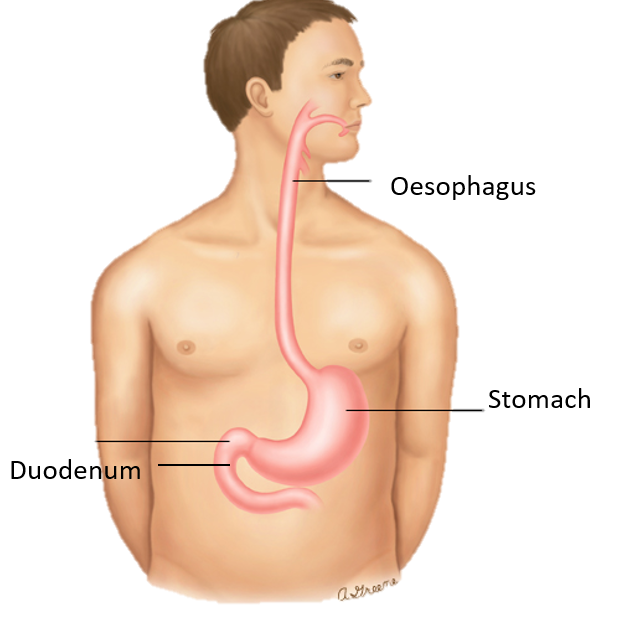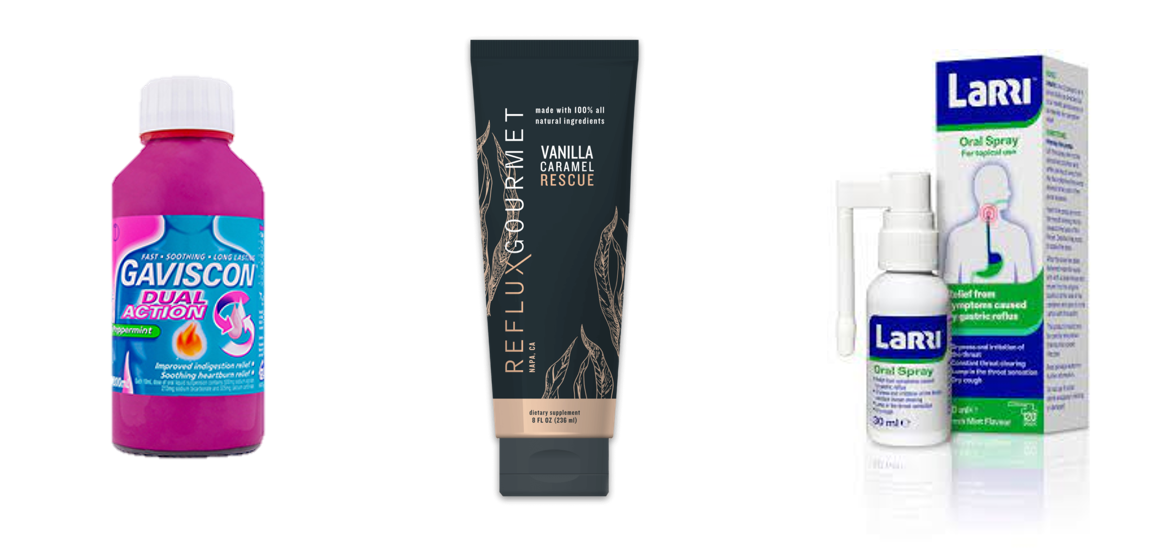Who is this information for?
This information is for patients, families and carers following a diagnosis of gastro-oesophageal or laryngopharyngeal reflux.
What is gastro-oesophageal reflux disease?
- Gastro-oesophageal reflux disease (GORD) occurs when acid from the stomach travels back up the oesophagus. Normally food travels from the mouth, down through the oesophagus and into the stomach. A ring of muscle at the bottom of the oesophagus, known as the lower oesophageal sphincter, contracts to keep the acidic contents of the stomach from refluxing into the oesophagus.
- In patients with GORD, the lower oesophageal sphincter does not close properly. This allows acid and other contents of the digestive tract to move up and reflux into the oesophagus.
- When stomach acid touches the lining of the oesophagus it can cause a burning sensation known as heartburn.
 What is laryngopharygeal reflux disease?
What is laryngopharygeal reflux disease?
- Laryngopharyngeal reflux disease (LPRD) occurs occurs when stomach acid refluxes beyond the oesophageal sphincter, into the back of the throat and possibly the back of the nasal airway.
- Adults with LPRD often do not complain of typical heartburn symptoms, which is why it is often known as “silent reflux”. Instead, they may complain of a dry cough, a hoarse voice, or a feeling of a lump in the back of their throat. Sometimes, they may complain of discomfort in their throat or a bitter taste.
- Rarely breathing difficulties can occur if the voice box is affected.
What are the symptoms of reflux disease?
Symptoms of GORD include:
- Heartburn and Acid regurgitation
- Excessive belching
- Nausea
- Occasional difficulty swallowing
Symptoms of LPRD include:
- Hoarseness
- Sensation of a lump in the throat
- Dry cough
- Sore throat
- Bad breath
- Difficulty swallowing
How are GORD and LPRD diagnosed?
- GORD & LPRD can be diagnosed on history, examination and by the patient’s response to treatment with medication.
- Additional tests may be undertaken such as a nasal endoscopic examination, though the findings on examination can often be due to non-reflux related causes, and so, are non-specific.
- Increasingly these days, patients may undergo objective testing such as:
- 24 hour pH Impedance monitoring – which tests for the reflux of liquids up the oesophagus and into the pharynx, and also measures the acidity (pH), of those liquids.
- This test is considered the ‘gold standard’ test for the diagnosis of GORD and LPRD
- Oral Salivary Pepsin Testing (Peptest) – which tests a patient’s saliva for the presence of pepsin, an enzyme only produced and secreted in the stomach.
- This test can be considered a useful screening test in patients where a diagnosis of LPRD is considered
- If the test is positive, the patient is highly likely to have LPRD
- If the test is negative, there is a chance it is falsely negative, and if symptoms and suspicion of LPRD persist, referral for the gold standard pH impedance testing
- If the test is negative, there is a chance it is falsely negative, and if symptoms and suspicion of LPRD persist, referral for the gold standard pH impedance testing
- 24 hour pH Impedance monitoring – which tests for the reflux of liquids up the oesophagus and into the pharynx, and also measures the acidity (pH), of those liquids.
What are the treatment options for GORD and LPRD?
- Dietary and lifestyle changes are the mainstay of treatment. Medications are also often used.
What dietary and lifestyle changes can be made to improve GORD and LPRD?
- Lifestyle Measures:
- Avoid eating or drinking within 2-3 hours of bed time
- Have your main meal at lunch, instead of dinner
- Eat small meals, and eat slowly
- Lose weight
- Wear loose clothing
- Stop smoking – if you smoke
- Elevate the head of your bed by 10-15 cm – if experiencing heartburn symptoms
- If possible, avoid the following drugs:
- NSAIDs – g. Nurofen
- Corticosteroids – g. Prednisone
- Aspirin
- Iron supplements
- Calcium channel blockers.
- Dietary Measures:
- Favour Foods
- Increase the tone of the upper & lower oesophageal sphincter, moderate the secretion of acid & pepsin, and decrease digestion time
- alkaline foods – g. Alkaline water, Apple/Pear/Banana Juice, chamomile tea
- proteins – lean meats, fresh fish, egg whites
- low-acid – g. asparagus, broccoli, mushrooms, cauliflower, green beans, turnip, parsley, tofu.
- low-fat – g. low fat cheese, skim milk
- Steamed or cooked vegetables.
- Increase the tone of the upper & lower oesophageal sphincter, moderate the secretion of acid & pepsin, and decrease digestion time
- Limit foods which…
- relax the upper & lower oesophageal sphincter, increase the secretion of acid & pepsin, and increase digestion time and thus potentially increase reflux.
- Caffeine – g. coffee, black tea, energy drinks
- Carbonated Drinks
- Chocolate
- Peppermint
- Tomato
- Fatty and fried foods – g. preserved meats, pork & lamb chops,
- Alcohol
- Raw greens, uncooked vegetables – as these tend to prolong gastric digestion.
- relax the upper & lower oesophageal sphincter, increase the secretion of acid & pepsin, and increase digestion time and thus potentially increase reflux.
- Limit foods which…
- are directly irritating to the lining of the throat and larynx, and potentially reactivating retained pepsin.
- Spicy foods
- Citrus Fruits
- Acidic foods.
- are directly irritating to the lining of the throat and larynx, and potentially reactivating retained pepsin.
- Favour Foods

What medication is available to manage GORD and LPRD symptoms?
| Medication Type | Medication Name Examples |
|---|---|
| Antacids | Calcium Carbonate – e.g. Andrews TUMS® |
| Aluminium Hydroxide, Magnesium Hydroxide, Simethicone – e.g. Mylanta®, Gastrogel® | |
| Surface Agents | Sucralfate – e.g. Carafate®, Ulcyte® |
| Sodium Alginate, Potassium Bicarbonate, Calcium – e.g. Gaviscon dual Action®, Reflux Gourmet®, Larri Oral Spray® | |
| Histamine Blockers | Ranitidine – e.g. Zantac®, Rani-2® |
| Nizatidine – e.g. Tazac®, Nizac®, Tacidine® | |
| Famotidine – e.g. Famotidine® | |
| Proton Pump Inhibitors | Esomeprazole – e.g. Nexium® |
| Omeprazole – e.g. Losec®, Acimax® | |
| Lansoprazole – e.g. Zoton®, Zopral® | |
| Pantoprazole – e.g. Somac®, Ozpan®, Gastenz®, | |
| Rabeprazole – e.g. Pariet®, Parzol® |
Histamine blockers and proton pump inhibitors (see above) remain very effective at treating oesophageal reflux symptoms (GORD), but have been shown to be far less effective at treating
- isolated laryngopharyngeal reflux disease (LPRD).
- Increasingly, the main-stay of LPR treatment is a combination of diet, lifestyle and surface agent/antacid such as Gaviscon® dual action, or Reflux Gourmet®, or Larri® Oral Spray.
- Medications targeting specific stomach enzymes, such as pepsin, believed to be one of the key causes of LPRD, are currently being trialled and may be a key treatment option in the near future.

Is Surgery an option?
- Rarely, symptoms of GORD/LPRD are so severe, and persistent despite adequate conservative and medical treatment, that surgery is considered.
- Before surgery is considered, objective testing is performed to prove the diagnosis
- Such surgery may involve a procedure to physically tighten the lower oesophageal sphincter to prevent reflux of gastric contents – e.g. Fundoplication
